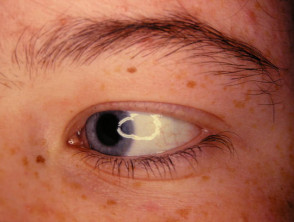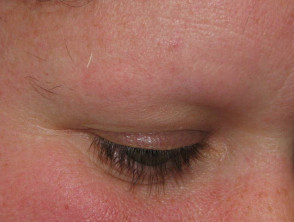What is madarosis?
Madarosis refers to loss of the eyelashes or eyebrows. It can be:
- Unilateral or bilateral
- Incomplete or complete
- Non-scarring or scarring.
In non-scarring madarosis, follicular structures are retained and it is potentially reversible. Scarring madarosis is due to deeper inflammation and fibrosis, and it is more likely to result in permanent lash and hair loss.
Loss of the eyelashes alone is also known as milphosis.
Who gets madarosis?
Madarosis can be found in both sexes and in any age group but, depending on the underlying cause, it is more common in older people.
What causes madarosis?
Madarosis is caused by any process that damages the hair bulb or hair shaft, leading to either temporary or permanent hair loss.
Common causes of madarosis include:
- Staphylococcal infection
- Herpes simplex
- Rosacea
- Alopecia areata
- Hypothyroidism (typically affecting bilateral outer one-third of eyebrow)
- Hyperthyroidism
- Atopic dermatitis
- Psoriasis
- Trauma
- Treatment-induced madarosis, such as that resulting from chemotherapy, radiotherapy, laser treatment, and botulinum toxin injection.
Madarosis
Uncommon causes of madarosis include:
- Discoid lupus erythematosus (DLE)
- Scleroderma
- Lichen planopilaris and frontal fibrosing alopecia
- Different types of skin cancer, such as intraepidermal carcinoma, basal cell carcinoma, squamous cell carcinoma or melanoma
- Infection-related madarosis, such as that resulting from dermatophyte (ringworm) fungus, atypical mycobacteria, leprosy, and human immunodeficiency virus (HIV)
- Vitamin A toxicity
- Drug toxicity (eg, thallium and cocaine)
- Genetic or congenital disorders (eg, ichthyosiform erythroderma, ectodermal dysplasia, cryptophthalmos, and Ehlers–Danlos syndrome)
- Psychiatric causes (eg, trichotillomania and dermatitis artefacta).
Madarosis
How is madarosis diagnosed?
Madarosis can be clinically diagnosed based on an adequate history and examination. Useful tests may include:
- Trichoscopy (dermoscopy of hair)
- Skin swabs for bacterial culture and laboratory tests for viral infections, such as polymerase chain reaction (PCR) assays
- Fungal scraping for microscopy and culture
- Skin biopsy
- Blood tests (eg, thyroid function and vitamin A levels).
What is the treatment for madarosis?
The specific treatment recommended for madarosis depends on its underlying cause (eg, antibiotics are recommended for madarosis caused by bacterial infection). Non-specific measures that can be used in madarosis include:
- Cosmetic camouflage
- False eyelashes and eyebrows
- Tattooing
- Minoxidil solution
- Topical prostaglandins (eg, bimatoprost)
- Hair transplant and eyelash grafting.

